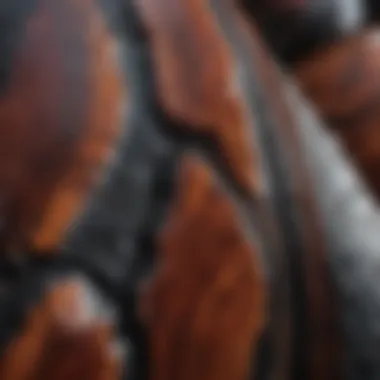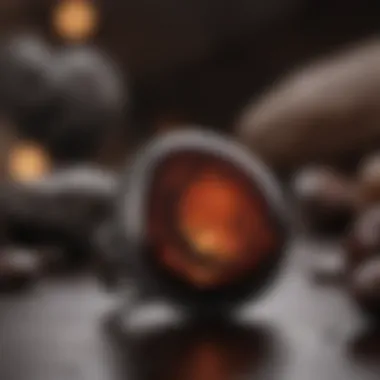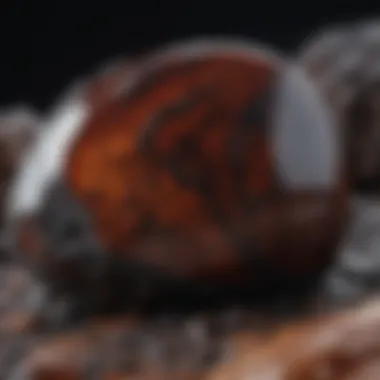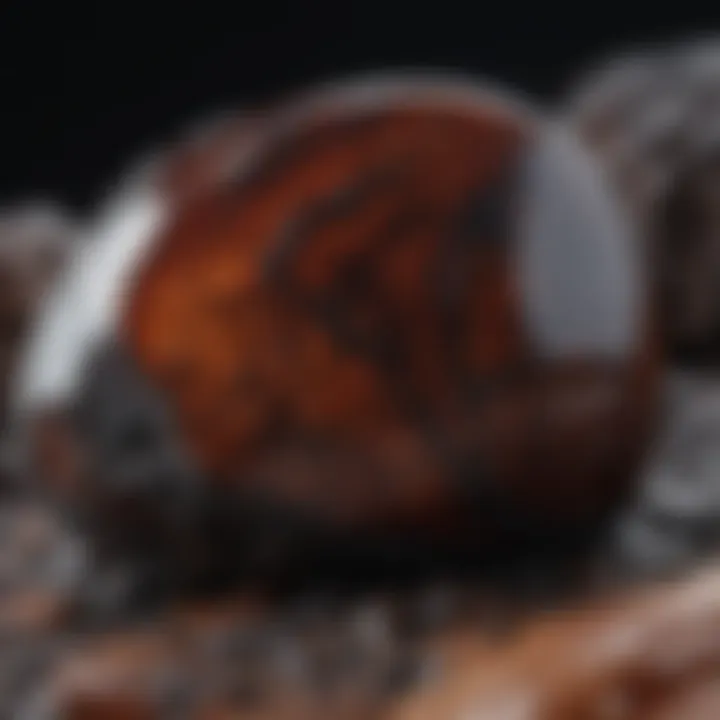Exploring Mahogany Obsidian Rock: Properties and Significance


Intro
Mahogany obsidian is a unique volcanic glass that has gained attention from collectors and enthusiasts alike. Its rich hues and interesting formation have made it a sought-after specimen in both geological circles and among those interested in the metaphysical properties attributed to stones. Understanding the origins, properties, and significance of mahogany obsidian enhances one's appreciation for this fascinating material.
History and Origins
Overview of Collectibles, Rocks, and Fossils
The world of collectibles often merges with the field of geology, creating a space where enthusiasts explore various stones and fossils. Each piece tells a story of the earth's history, providing insight into geological processes and ancient environments. Mahogany obsidian, with its dark and warm tones, fits well into this narrative. It is not merely a decorative item; it has a rich genealogical background that dates back to several ancient cultures that valued it for both practical and aesthetic purposes.
Historical Significance and Cultural Impact
Historically, mahogany obsidian has been used by many Indigenous peoples for making tools and weapons due to its sharp edges when fractured. It was also believed to have protective qualities, often used in amulets. In some cultures, such as among the Mesoamericans, obsidian served a critical role not just in daily life, but also in ceremonial contexts. Its significance goes beyond utility; it resonates with themes of beauty and power, representing the interconnectedness between nature and human existence.
Identification and Classification
Guide to Identifying Rocks and Fossils
Identifying mahogany obsidian requires attention to a few key characteristics. Its dark reddish-brown color, often resembling the wood from a mahogany tree, distinguishes it from other forms of obsidian. The glassy luster and conchoidal fracture pattern serve as useful identifiers. One can gauge the quality by checking for inclusions and clarity, as high-quality pieces tend to have a smoother finish.
Common Types and Variations
Mahogany obsidian comes in a few common variations, each with its own distinct features. Here are some notable types:
- Mahogany Obsidian: Characterized by its deep reddish-brown color with black swirls.
- Snowflake Obsidian: Contains white patches resembling snowflakes, offering a stark contrast to its dark body.
- Rainbow Obsidian: Displays a shimmering effect, with colors that can appear when light hits the surface at certain angles.
These varieties not only display aesthetic differences, but they also reflect the diverse geological conditions under which they formed.
Understanding the properties of mahogany obsidian enriches the collector's experience, connecting them deeply to the earth’s history.
Collecting rocks, especially distinct varieties such as mahogany obsidian, offers a rewarding journey. Whether for purely aesthetic purposes or exploring the scientific and cultural significance, the world of mahogany obsidian is captivating.
Preface to Mahogany Obsidian
Mahogany obsidian holds a unique position in both geological and cultural discussions. This volcanic glass, known for its rich, warm hues and striking patterns, is of particular interest to collectors and enthusiasts alike. Understanding mahogany obsidian involves not only studying its physical and chemical properties but also exploring its historical and cultural contexts. This section delves into the definition of mahogany obsidian and its composition, laying the foundation for deeper investigations into its significance and uses.
Definition and Composition
Mahogany obsidian is a natural volcanic glass formed by the rapid cooling of lava, which prevents the crystallization of minerals. Its composition mainly includes silicon dioxide, with variations based on trace elements that influence color. The dominant reddish-brown coloration, akin to mahogany wood, comes from iron and hematite inclusions. This distinct color and shine make it appealing for both ornamental and practical purposes.
Significantly, mahogany obsidian is categorized as a type of obsidian, which is a broader category encompassing other colors such as black, green, and snowflake obsidian. Each type has unique visual characteristics, but what sets mahogany obsidian apart is its rich warmth. The presence of volcanic gases can also contribute to its texture, leading to the presence of bubbles or iridescence in some specimens.
Historical Context
Historically, mahogany obsidian has been utilized by various cultures for thousands of years. Indigenous peoples in North America and Mesoamerica crafted tools and weapons from this rock, valuing its sharp edges and durability. It was not just a practical resource; it also held cultural and spiritual significance. Many ancient civilizations believed obsidian provided protective qualities and used it in rituals.
Artifacts made from mahogany obsidian have been found in archaeological sites, indicating trade routes where this rock was a valuable commodity. Its historical legacy continues today in how collectors view and value this unique material. To some, owning a piece of mahogany obsidian connects them with a rich lineage of human innovation and cultural significance.
"Mahogany obsidian is not merely a geological specimen; it embodies a profound narrative of human interaction with the natural world. The stories embedded within its layers span generations and cultures."
As we further explore mahogany obsidian, we will look into its geological formation, physical properties, and essential roles in contemporary culture.
Geological Formation of Mahogany Obsidian
The geological formation of mahogany obsidian is a crucial aspect of understanding its unique properties and significance. This section delves into the processes that contribute to the emergence of this volcanic glass. From the molten state of lava to solidification, these processes reflect the natural forces that shape the earth. Comprehending the geological formation helps collectors and enthusiasts appreciate mahogany obsidian not just as a collectible, but as a result of geological phenomena.
Volcanic Activity and Glass Formation
Mahogany obsidian originates from the rapid cooling of volcanic lava. When lava erupts and comes into contact with the atmosphere or water, it cools quickly. This swift cooling prevents crystal growth, which is typical in many igneous rocks. Instead, it creates a glassy texture, making mahogany obsidian stand out. The distinct reddish-brown hues seem to derive from iron oxide within the original magma, giving it a unique appearance.
The volcanic activity responsible for this formation comes from specific tectonic settings. Subduction zones, where one tectonic plate moves under another, typically lead to the formation of this volcanic glass. Such locations are rich in materials that contribute to the color and texture of the obsidian.
Formation Conditions
Conditions during the formation of mahogany obsidian are vital for its characterization. Factors such as temperature, pressure, and the chemical composition of the molten lava influence the final product. The rapid cooling not only results in the glassy texture but also affects the clarity and patterning within the obsidian.
Where mahogany obsidian forms can also impact its quality. Collection from certain geographical locations can yield varieties with more pronounced patterns. For example, obsidian found near hot springs may display unique streaks and colors. Understanding these conditions allows collectors to make informed selections and recognize the value of different specimens.
"Each piece of mahogany obsidian tells a story of the earth's dynamic processes and the conditions of its formation."
In addition to the geological context, recognizing the conditions leading to the creation of mahogany obsidian enhances its significance. This knowledge aligns well with the interests of rock and fossil collectors, who often seek a deeper understanding of their specimens. Familiarity with formation conditions can also guide enthusiasts in seeking out specific types for their collections.
Physical Properties
The physical properties of mahogany obsidian are critical in understanding its overall significance and application. These properties determine not just its aesthetic appeal but also its functionality in various use cases. Identifying the unique aspects of mahogany obsidian aids collectors and enthusiasts in making informed decisions regarding its display, maintenance, and potential investment value. Therefore, examining the specific elements that contribute to its distinctive features is paramount.
Color Variations and Patterns
Mahogany obsidian is known for its rich, deep colors and unique patterns. Typically, it presents a dark brown or reddish-brown hue, which can sometimes exhibit a translucent quality due to its glassy nature. The variations in color are influenced by the iron and magnetite inclusions within the stone. These impurities create beautiful swirls and banding, enhancing the visual appeal of this volcanic glass.


The patterns are not only visually striking but serve a purpose in how collectors evaluate the stone. Higher-quality specimens often display more intricate patterns, making them more desirable in the collectors’ market. In this context, one might note that the aesthetic aspects linked to color and patterns can dramatically affect its market value.
"The unique patterns found in mahogany obsidian are more than just decorations; they hold the key to understanding its origin and quality."
Hardness and Texture
The hardness and texture of mahogany obsidian are significant from both a practical and aesthetic standpoint. On the Mohs scale of mineral hardness, mahogany obsidian registers around a 5.5 to 6. This moderate hardness allows it to be shaped and polished, making it suitable for various applications, such as jewelry and decorative items.
The texture is typically smooth, adding a luxurious feel that appeals to users. As for care, its glass-like quality may require gentle handling to avoid scratches and damage. Those familiar with rock and fossil collecting recognize that the balance between hardness and fragility is an important consideration when preserving the integrity of mahogany obsidian.
Understanding these properties contributes to a deeper appreciation of mahogany obsidian in both practical and collectible contexts.
Cultural and Historical Significance
Cultural and historical significance of mahogany obsidian extends beyond its striking appearance. This volcanic glass has been valued by various cultures for millennia, showcasing its importance in social, artistic, and economic contexts. Recognizing the role of mahogany obsidian provides insights into the traditions and practices of ancient civilizations. It acts as a bridge to understanding their societies, belief systems, and artistry.
Use in Ancient Cultures
Mahogany obsidian was utilized by several ancient cultures for a wide range of purposes. For instance, the Aztecs and Olmecs crafted tools and weapons from this material, taking advantage of its sharp edges and durability. The hardness of mahogany obsidian made it ideal for functional items such as knives and scrapers, essential for daily survival tasks like hunting and food preparation.
Additionally, it was not merely a utilitarian stone. The aesthetic qualities of mahogany obsidian captured the attention of artisans. Intricate carvings and ornamental pieces were created, highlighting its beauty and the skill involved in working with it. Such artifacts served ceremonial purposes and were often used in rituals, indicating a deeper cultural relevance.
Symbolism and Beliefs
Beyond practical applications, mahogany obsidian has held various symbolic meanings throughout history. It is often associated with grounding energies and protection against negativity. For many, this stone was believed to harbor mystical properties, aiding in introspection and emotional healing. In spiritual practices, mahogany obsidian is thought to help individuals connect with their inner selves and confront past traumas.
Cultures have ascribed significance to mahogany obsidian in different ways, depending on their myths and available resources. Some communities viewed it as a protective talisman, believed to guard against physical and psychic injuries. In many belief systems, the connection to earth and the volcanic origin of the stone enhance its status as a powerful spiritual tool.
"Mahogany obsidian is not just a material; it embodies the legacy of those who used it, reflecting their values and beliefs."
Understanding the cultural and historical significance of mahogany obsidian enriches our appreciation of this geological marvel. This awareness enhances the connection between collectors and the artifacts they hold, fostering a deeper comprehension of their origins and meanings.
Metaphysical Properties
The metaphysical properties of mahogany obsidian often captivate interested collectors and enthusiasts. This particular volcanic glass is not only lauded for its striking appearance but also for its perceived spiritual and healing benefits. Understanding these properties offers valuable insights for those who appreciate this unique rock.
Healing Properties
Mahogany obsidian is frequently regarded as a protective stone. It is said to absorb negative energies, assisting individuals in overcoming challenging emotional states. This type of obsidian is believed to offer grounding energy, connecting the user with the earth. Many users report that holding or carrying this stone helps in fostering a sense of stability during turbulent times.
The healing properties of mahogany obsidian can include:
- Alleviating emotional trauma
- Promoting emotional clarity
- Providing support during times of change
Furthermore, advocates of this rock often suggest meditating with mahogany obsidian to access its healing capabilities. The calming energy may help relieve stress and anxiety, contributing to overall well-being.
Spiritual Significance
On a spiritual level, mahogany obsidian is often associated with enhanced personal power. Many believe it can aid in the development of intuition and self-awareness. This stone is thought to facilitate deep soul searching, helping individuals uncover hidden truths about themselves.
Some key aspects of its spiritual significance include:
- Enhancing psychic abilities
- Encouraging introspection
- Facilitating spiritual growth
Using mahogany obsidian in meditation practices can help individuals tap into its purported spiritual insights. The stone may assist in setting positive intentions and manifesting desired outcomes.
"The use of stones like mahogany obsidian in spiritual practices allows individuals to connect more profoundly with their inner selves".
In summary, the metaphysical properties of mahogany obsidian encompass a rich blend of emotional healing and spiritual growth. By exploring these qualities, collectors gain a deeper appreciation for this remarkable volcanic rock.
Uses of Mahogany Obsidian
Mahogany obsidian is not just an intriguing geological specimen; it has numerous practical applications that highlight its unique qualities. This section discusses its significance in various domains, such as jewelry and tools, while emphasizing the benefits and important considerations involved in using this volcanic rock.
Jewelry and Decorative Items
Mahogany obsidian is often favored in the creation of jewelry. Its rich color and unique patterns make it an attractive choice. Artisans frequently utilize it in necklaces, earrings, bracelets, and rings. The stone’s inherent beauty can enhance any piece, allowing for versatile designs.
Moreover, properties such as durability add to its value in jewelry. Unlike many other gemstones, mahogany obsidian resists scratching and damage effectively. This makes it a practical option for daily wear, as it maintains its appearance over time with proper care. Pieces made from mahogany obsidian often appeal to those who appreciate natural materials, connecting them to the Earth in a personal way.
However, while mahogany obsidian is commonly found, not all pieces are created equal. Collectors should be aware of the quality of the stone when selecting items for their collection. Authentic mahogany obsidian features a smooth surface and distinct patterns, unlike imitations or lower-quality versions that may lack depth in color.
Tools and Weapons
Historically, mahogany obsidian was extensively used for crafting tools and weapons. Its sharp edges, formed during the cooling process of volcanic glass, made it an excellent material for cutting and piercing implements. Ancient cultures, such as the Aztecs and Native Americans, valued this property greatly, utilizing it in projectile points, blades, and other tools essential for survival.
In modern contexts, certain collectors or artisans continue to create replicas of these historical tools. This practice preserves traditional crafting techniques and highlights the resourcefulness of ancient civilizations. Additionally, tools made from mahogany obsidian can still hold functional value today. Many enthusiasts appreciate their aesthetic appeal and cultural significance, often showcasing them in collections or educational settings.
Maintaining the integrity of tools crafted from mahogany obsidian is crucial. Proper cleaning and storage are necessary to prevent chips or damage. As with jewelry, long-term preservation hinges on understanding the materials involved, making knowledge about mahogany obsidian vital for collectors.


"The sharpness of obsidian has made it a favored material for tool-making throughout history, demonstrating both function and art."
Mahogany Obsidian in Collecting
The appreciation for mahogany obsidian extends beyond its aesthetic appeal; it serves as a significant focal point for collectors. The unique characteristics and variety of this volcanic glass not only attract enthusiasts but also present challenges and considerations in the collecting realm. For collectors, understanding why mahogany obsidian is sought after is essential. Its historical context, physical properties, and metaphysical beliefs contribute to its allure.
Value Assessment
Determining the value of mahogany obsidian is crucial for collectors, both for buying and selling. Various factors play a role in the assessment of its worth:
- Quality of the Rock: Higher quality specimens display more vibrant color patterns and clarity. Those with striking hues of brown and red are typically more desirable.
- Size and Shape: Larger pieces or those formed into unique shapes can command a higher price. Natural formations may be more appealing than cut pieces.
- Source and Authenticity: The point of origin can affect value. Specimens from well-known locations may hold more significance. Collectors should verify authenticity to avoid potential fakes.
- Market Demand: Trends in the collectibles market can influence prices. During times of high interest in rock and gem collecting, values can increase significantly.
These elements come together to create a complex valuation landscape for mahogany obsidian. Knowledge of current market trends and a deep understanding of individual pieces can prevent overpaying or underselling.
Care and Maintenance
Proper care and maintenance of mahogany obsidian is vital for preservation and longevity. The following guidelines help ensure that the beauty of mahogany obsidian is sustained:
- Cleaning: Use a soft cloth to gently wipe the surface. Avoid harsh chemicals which can damage the rock.
- Storage: Keep in a dry place to prevent moisture damage. Use padded containers to avoid scratches.
- Avoiding Heat: Extreme temperature fluctuations can crack obsidian. Store at a consistent, moderate temperature.
- Inspection: Regularly check for signs of damage, such as chips or cracks, and address them quickly to prevent further deterioration.
By adhering to these care practices, collectors can maintain the integrity and beauty of their mahogany obsidian pieces for years to come.
"Understanding the value and care of mahogany obsidian is essential for every serious collector."
Market Trends and Demand
The significance of market trends and demand for mahogany obsidian rock cannot be overstated, especially for collectors and enthusiasts. Understanding these trends is crucial in navigating the complexities of the collectibles market. As consumers express a growing interest in unique geological specimens, mahogany obsidian stands out due to its distinct aesthetic appeal and metaphysical associations. This section will provide insights into the current dynamics influencing mahogany obsidian's market presence and potential future growth.
Current Market Overview
The collectors’ market for mahogany obsidian is experiencing notable changes. Several factors contribute to this evolving landscape:
- Rising Interest: There has been an increase in interest among rock and fossil collectors. Social media platforms and forums have created communities focused on the appreciation of unique geological materials. The visual allure of mahogany obsidian, characterized by its rich colors and patterns, attracts many.
- Sustainability Concerns: More collectors now consider the ethical sourcing of materials. Sustainable practices in mining and collecting are becoming a priority. This awareness can boost the appeal of mahogany obsidian, as it is often naturally sourced, contrasting with artificially manufactured collectibles.
- Pricing Trends: Pricing for mahogany obsidian varies widely based on quality and rarity. Customers need to understand that well-preserved specimens can fetch higher prices, while less desirable pieces remain more affordable. Collectors are encouraged to familiarize themselves with market prices, which change frequently based on demand and availability.
Predicted Growth in Collectibles
Future predictions suggest that the collectibles market for mahogany obsidian could see significant growth. Here are some key considerations driving this outlook:
- Increased Cultural Interest: As more people explore the metaphysical properties of stones, interest in mahogany obsidian is likely to rise. Its perceived benefits, such as protection and grounding, make it appealing to a broader audience.
- Expanding Market Access: Online marketplaces are making it easier for collectors to buy and sell natural rocks and minerals. A growing number of sellers specialize in collecting and showcasing mahogany obsidian, thus enhancing its market presence.
- Investment Opportunities: As collectors view geological specimens as potential investments, mahogany obsidian's rarity and unique attributes position it well. Speculators may begin to see this volcanic glass as a rewarding investment choice.
"The rise of both online platforms and sustainable collecting practices signals a promising future for mahogany obsidian in the collectibles market."
In summary, the market trends and demand for mahogany obsidian rock reflect a dynamic and evolving landscape. By paying attention to current market dynamics and anticipated growth, collectors can make informed decisions in their pursuit of this exceptional volcanic glass.
Comparative Analysis
In this section, we will delve into the comparative analysis of mahogany obsidian, an essential part of understanding its place in the world of geological materials. The importance of this analysis lies in its ability to provide clarity on how mahogany obsidian stands out among other obsidian types and geological materials. This section not only highlights the unique characteristics of mahogany obsidian but also juxtaposes these features against its counterparts, giving insight into its significance and appeal for both collectors and geologists.
Comparison with Other Obsidian Types
Mahogany obsidian is one of several varieties of obsidian, which is a naturally occurring volcanic glass. Each type has distinct features that enhance its desirability. Notably, mahogany obsidian is distinguished by its unique reddish-brown tones mixed with black swirls, which can create striking visual patterns.
In contrast, other types like black obsidian lack this variety of coloration. Black obsidian is predominantly one color and lacks the depth of visual appeal found in mahogany. Another variety, rainbow obsidian, displays a play of colors that gives it an iridescent effect, which differs distinctly from the earthy tones of mahogany. Each type serves different purposes, from decorative pieces to tools used in ancient cultures.
The differences in composition and appearance are vital for collectors to consider. Collectors may favor mahogany obsidian for its rarity in certain regions or its aesthetic qualities when compared to more common types of obsidian.
Differences with Other Geological Materials
When comparing mahogany obsidian with other geological materials, it is essential to consider the formation process. Mahogany obsidian forms rapidly during volcanic eruptions when lava cools quickly. Other materials, like granite, undergo a much longer cooling process, resulting in a crystalline structure rather than a glassy one. This distinction directly affects the texture and appearance of the materials.
Additionally, while some minerals, like quartz and feldspar, can exhibit similar colors to mahogany obsidian, they possess different physical properties. For instance, quartz is significantly harder and more durable compared to the relatively softer mahogany obsidian.
"Understanding the comparative aspects of mahogany obsidian allows collectors to appreciate its uniqueness more deeply, facilitating informed decisions about collection priorities."
In summary, a thorough comparative analysis reveals not only the unique qualities of mahogany obsidian but also its place in a wider geological context. For collectors, recognizing these differences enhances both their appreciation of this volcanic glass and informs their collecting strategies.
Environmental Considerations
Understanding environmental considerations related to mahogany obsidian rock is essential for several reasons. Firstly, it underscores the importance of sustainable practices in obtaining this geological material. Given the diverse uses of mahogany obsidian, from jewelry to decorative items, the demand placed on its natural sources can have significant impacts if not managed appropriately. Ensuring responsible sourcing is not just about protecting natural resources but also about maintaining the ecological balance of the areas where it is found.
Sourcing and Sustainability
Mahogany obsidian is primarily sourced from volcanic regions. The process of sourcing this rock must align with sustainability principles to minimize negative environmental impacts. Sustainable sourcing means that the extraction of mahogany obsidian should not lead to habitat destruction or significant ecological disruption. Moreover, transparent supply chains are crucial. Collectors and enthusiasts should seek providers who follow ethical practices, ensuring that the rock is sourced responsibly.
- Encouraging local community involvement in the sourcing process can promote sustainable practices.
- Certification programs can help identify products that are sourced ethically.
- Awareness of the environmental costs involved in mining should lead collectors to opt for responsibly sourced rock.
Incorporating sustainability into sourcing not only benefits the environment but also enhances the value of the mahogany obsidian as a collectible item, as modern collectors often value ethically sourced materials.
Impact of Mining Practices


Mining practices for mahogany obsidian can vary significantly in their environmental footprint. Unregulated extraction methods can lead to severe landscape changes and destruction of local ecosystems. For example, removing large quantities of rock from an area can disrupt the natural habitat for numerous species, affecting biodiversity.
- Soil Erosion: Poor mining practices can lead to soil erosion, which affects plant life and water quality in surrounding areas.
- Water Pollution: The use of chemicals in mining processes may contaminate local water sources, posing risks to both wildlife and human populations.
- Community Impact: Local communities often bear the brunt of these environmental changes, facing challenges related to water resources and land degradation.
Ultimately, a concerted effort to adopt more sustainable mining practices is vital for preserving the ecological and cultural value of mahogany obsidian. The future of this unique volcanic glass relies heavily on the adoption of responsible extraction techniques and respect for the environments from which it is sourced.
It is essential for collectors to be aware of the environmental ramifications of mining practices and to advocate for sustainable approaches.
Resources and References
In exploring mahogany obsidian, a detailed understanding of the topic is essential. Resources and references are critical for anyone interested in furthering their knowledge about this unique volcanic glass. The study of mahogany obsidian requires not only an appreciation of its physical and metaphysical properties but also an awareness of its cultural significance and geological origins. By accessing various resources, readers can enhance their comprehension and engage more fully with the existing body of knowledge surrounding this material.
The modern collector or enthusiast should consider several key components when utilizing resources. Firstly, engaging with academic literature allows for a more rigorous insight into the complexities of mahogany obsidian. It is important for readers to seek out scholarly articles, books, and research papers that offer vetted information.
The benefits of recommended reading include:
- Access to authoritative sources that validate claims about the properties and significance of mahogany obsidian.
- Exposure to varied perspectives, thus enriching one’s own understanding of the material.
- Opportunities for critical thinking while evaluating contrasting theories or findings related to this volcanic glass.
Moreover, it is crucial to consider the practical applications of mahogany obsidian within the realms of both the geological sciences and the collectibles market. The information derived from trusted references can shape collecting practices and inform ethical sourcing, as sustainability becomes increasingly important in today’s market.
"A knowledgeable collector is empowered by the resources they engage with. Awareness of literature reflects a deeper understanding of the subject matter."
Recommended Reading
Reading material both on mahogany obsidian and related geological concepts offers a grounding in essential knowledge. Titles such as "Obsidian: The Dark Stone" by Paul R. Steinberg and "Volcanic Rocks and Their Origin" may provide a comprehensive background on the topic. Many enthusiasts also appreciate works that delve into the cultural history of stone tool use, such as books on Native American craftsmanship.
Some useful sources may include:
- Books on obsidian types and uses
- Geological surveys and magazines dedicated to mineralogy
- Online forums and community discussions focused on rock collecting, available on platforms like Reddit and Facebook
Research Papers and Academic Resources
Engaging with peer-reviewed research papers is invaluable for obtaining accurate data. Academic journals frequently publish articles that examine the properties, formation processes, and societal implications of materials like mahogany obsidian.
Notable resources include:
- The Geological Society’s publications
- Journals on mineralogy and geology that provide insights backed by empirical evidence
- Theses and dissertations available through university databases, which can present unique studies focused on this volcanic glass
Collectively, by utilizing these resource avenues, enthusiasts and scholars can ensure a more informed approach to the appreciation, collection, and use of mahogany obsidian.
Community Engagement
Community engagement plays a significant role in enriching the discussion surrounding mahogany obsidian. This topic transcends mere curiosity and enters the realm of shared knowledge among enthusiasts, collectors, and scholars. By fostering a dialogue, individuals can learn about the unique properties, historical backgrounds, and current market trends of this volcanic glass. Engagement also includes sharing personal experiences and uses, which cultivates a deeper appreciation and understanding of mahogany obsidian's significance.
Discussion Forums and Groups
Within the realm of rock and mineral collecting, discussion forums and groups provide critical spaces for exchange. These online communities—such as those found on Reddit or specialized Facebook groups—serve as platforms where members can ask questions, share discoveries, and seek advice. Topics can range from the origins of different specimens to the evaluation of their market value.
Participants can also discuss their experiences regarding sourcing, care, and maintenance, ensuring collective knowledge grows.
Forums also offer opportunities for networking, which can lead to collaborations on research or even trading specimens. Individuals interested in obtaining rare pieces benefit greatly from these connections. Therefore, engaging in these forums can help collectors not only expand their collection but also deepen their understanding of mahogany obsidian.
Events and Exhibitions
Events and exhibitions focusing on gemstones and minerals can serve as vital venues for community engagement. They allow collectors to experience mahogany obsidian firsthand and observe its various forms and colorations. Such gatherings provide opportunities to meet with experts and fellow enthusiasts face to face, which can be invaluable.
Additionally, workshops offered during these events can enhance participants' knowledge about the geological and metaphysical aspects of the stone. Engaging with reputable speakers adds credibility and depth to the topics discussed. Following up on these events through social media or online platforms ensures continued interaction and sharing of insights among attendees.
In summary, the role of community engagement cannot be understated. It serves not just to inform but also to connect individuals around a shared passion for mahogany obsidian and its many facets.
Closure
The conclusion holds a significant role in summarizing the insights gathered throughout the article. Here, we encapsulate the essence of mahogany obsidian, including its geological, cultural, and metaphysical aspects, which have been discussed previously. This section serves as an important reflection on whole topic, allowing readers to appreciate the diverse layers that mahogany obsidian presents.
One primary element is the geological importance of mahogany obsidian. Its unique formation process under specific volcanic conditions speaks to the fascinating interactions of natural forces. Additionally, this volcanic glass does not merely serve as a material; it is a canvas of history and culture, revealing ancient usages and beliefs from various groups around the world.
Moreover, benefits include an enhanced connection with nature through understanding the volcanic origins and the significance of this material in human history. Having a clear awareness of these elements can be enriching for collectors and enthusiasts alike, as it extends beyond mere aesthetics to the narratives embedded within each piece.
Considerations about mahogany obsidian also touch on its place in modern society. As collectors seek out unique specimens, the rock’s value is perpetuated, demonstrating that interest in natural history and geology remains alive.
Summary of Key Insights
In summary, mahogany obsidian is more than just a rock. Its properties, origins, and cultural significance shape our understanding of both geology and human history. Key insights include:
- Geological Attributes: Unique volcanic origins lead to distinct physical features.
- Cultural Relevance: Ancient civilizations utilized this rock for tools and ornaments, revealing a longstanding appreciation for its qualities.
- Metaphysical Beliefs: Many regard mahogany obsidian as a source of healing and spiritual connection, illustrating the interplay between materials and personal beliefs.
- Market Demand: The collectors' landscape surrounding mahogany obsidian is evolving, reflecting a broader appreciation for unique geological specimens.
Future Perspectives
Looking ahead, the study and appreciation of mahogany obsidian may broaden significantly. As environmental considerations gain more traction, the focus on sustainable sourcing presents new challenges and opportunities for collectors. Understanding how extraction and consumption impact local ecosystems may lead to a more responsible approach in the collecting community.
The interest in rock and fossil collecting continues to grow, complemented by a surge in educational awareness. As enthusiasts dive deeper into the narratives behind materials like mahogany obsidian, we may see an increase in workshops, discussions, and shared resources.
Furthermore, the intersection of technology with geology opens doors to new methods of studying and appreciating these natural wonders. The potential for augmented reality experiences, detailed interactive displays, and virtual lectures may enhance accessibility and understanding for new generations of collectors.
To sum up, mahogany obsidian stands as a compelling example in the discourse of geological materials, marrying the tangible and the intangible. The future promises further exploration and appreciation.



